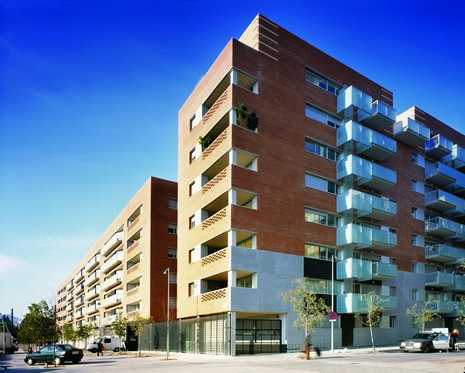Description
This project description is an excerpt from the longer article “Urban Block Shapers”. For a comparative analysis and further data including accompanying graphs, please see the article “A Turning Point”.
The plan by MAP Arquitectos for the H-2 and H-3 Blocks was to have taller, continuous perimeter blocks surrounding low-rise bars in the center, as predetermined in the urban design guidelines. The perimeter buildings are fairly conventional, and are double-layered on the west and east sides of the block separated by a void of nearly eight meters. These ‘sandwich’ buildings have a depth of approximately 10 meters, while the singular bar continuations that wrap around the north and south sides of the block range from around 12 to 13 meters. Passages are created along the major streets providing access into the courts, while a sense of intimacy is still maintained by the enclosure of apartment buildings containing 120 dwelling units. The central void with the garden/pool facilities constitutes the structuring device of the scheme, continuing underneath the inner band of the perimeter block that has been raised on the
In the nine-storey-tall parallel perimeter buildings, the floor plans are mirrored on each side, and each unit efficiently accommodates three bedrooms, two bathrooms, and built-in storage. Apart from these three-bedroom units, the complex also offers a range of smaller one- and two-bedroom units, as well as duplexes in the low-rise bars fronting the pedestrianized Passatge Posoltega bisecting the H-2 and H-3 Blocks. Access to the perimeter ‘sandwich’ buildings is marked by colorful island-like lobby entrances on the ground floors, interspersed with lightly vegetated patches extending the lawn into the vertical patio. The brown brick façades are kept relatively simple, punctuated by sheltered terraces as well as open-air balconies that add a touch of lightness to the project’s compact mass. Given its immediate adjacency to Barcelona’s largest open-air shopping mall designed by Manuel de Solà-Morales, the need for commercial and retail programs on site, as was the case of the Villa Olímpica blocks or the mixed-use fabric of the Eixample, was completely eliminated.
Drawings
Axonometric site plan of the La Maquinista urban development area
Sectional perspective view of entire building complex within its specific urban context
Site plan, scale 1:10000
Site plan illustrating the building’s contextual connectivity
Standard floor, scale 1:3000
Standard floor plan segment, scale 1:500
Cross section showing usage distribution, scale 1:3000
Residential unit types and distribution, scale 1:750
Photos

Exterior street view

Exterior courtyard view
Originally published in: Peter G. Rowe, Har Ye Kan, Urban Intensities: Contemporary Housing Types and Territories, Birkhäuser, 2014.